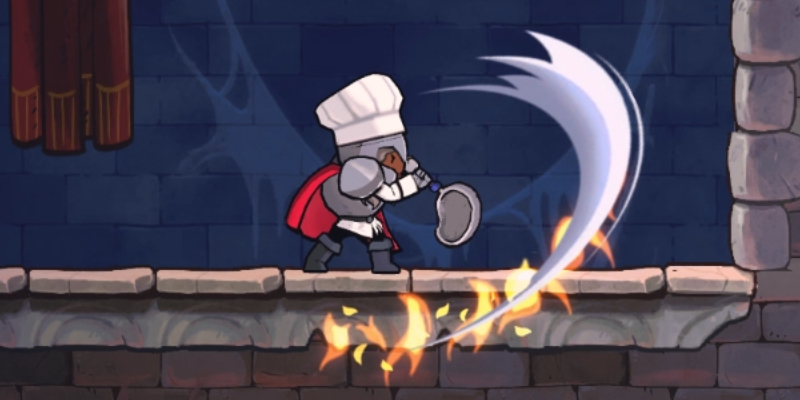The Chef is the first unconventional class available in Rogue Legacy 2. While most other classes use blades, bows, and guns, the Chef sticks to their trusty kitchen tools. Even so, this cook shouldn’t be messed with. Despite the Chef’s below-average health, the class more than makes up for it in other areas. One of these areas is its huge Mana pool that is comparable to even the Mage. The Chef class is certainly unusual, but our guide will help you maximize its potential in Rogue Legacy 2.
Unlocking the Chef requires your castle to be at level 18. Depending on which order you unlock Castle Upgrades you may reach the Chef before this level. If so it is advised to upgrade Strength through Arsenal which is an upgrade that becomes available after unlocking the Valkyrie class. You’ll want to maximize Arsenal out in the future anyway so it doesn’t hurt to gain some extra Strength early on. Be sure to spend at least one point on Study Hall though as this is necessary to unlock the Chef.
Frying Pan
Compared to a Saber or a Labrys, the idea of going to war with a Frying Pan may not sound appealing, but this piece of cookware is lethal. The Frying Pan deals great damage and has good range for a melee weapon. Its attack speed is fairly quick, comparable to the Knight’s Great Sword.
Perhaps the best trait of the Frying Pan is that its usefulness isn’t solely found in its offensive capabilities. It can also be used to deflect most projectiles back at enemies that fire them. If a projectile is successfully deflected, the Charged buff is applied for three seconds. While Charged, the next attack with the Frying Pan will always deal critical damage. The Charged buff is applied regardless of if the deflected projectile hits an enemy. Although, if you do land the shot, it will also inflict the Burn debuff, dealing damage over time.
Stew
Given the Frying Pan’s defensive playstyle, it’s appropriate that the Chef’s talent in Rogue Legacy 2 also favors taking things slow. Stew is a talent that supplies a free heal whenever it is off cooldown. The amount that Stew heals scales with Intelligence, not Vitality. This means that to keep this talent relevant, you need to purchase Castle Upgrades and equipment that increases Intelligence. Stew also instantly recovers 100 Mana when used, and this doesn’t change regardless of stats.
The downside to Stew is that it doesn’t use a traditional time-based cooldown. If it did, then it would be one the best talents in the game, as you could stall out and indefinitely heal. Instead, Stew gains a charge of use for each Health Drop that is picked up. To make the most of this, it is important to break as many objects as possible to maximize your chance of receiving Health Drops. Don’t be afraid to use Stew when necessary, as it’s better to use up its charges and live than to not use it and die. Runs in Rogue Legacy 2 are too short to justify holding onto it for the right moment.
Artisan
The raw damage of the Chef isn’t that great compared to some other classes in Rogue Legacy 2. However, this flaw is mitigated by the class’ passive ability, Artisan. Artisan makes it so that any damage dealt by the Chef applies the Burn debuff, which deals a lot of damage over three seconds.
An interesting side mechanic of Burn is that it can be used to secure critical hits. The Chef’s Burn hits six times, of which the last two make it so that any other damage dealt in that window will be critical. Learning the timing of this can be tricky but with practice, this can make the Chef an excellent counter-attacking class. Hit an enemy with a swing, bide your time, and then attack again towards the end of the Burn’s duration to deal extra damage.
Note: For more information, check out our Rogue Legacy 2 guides and features hub.










Published: May 5, 2022 01:00 pm